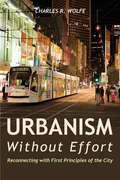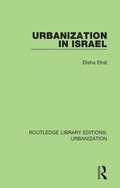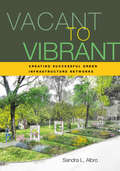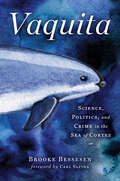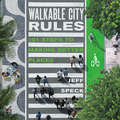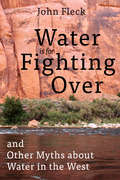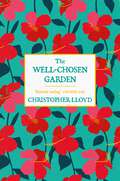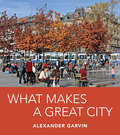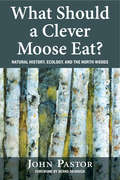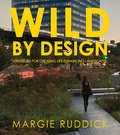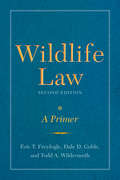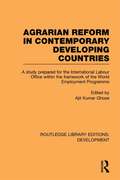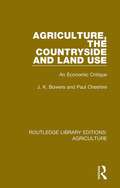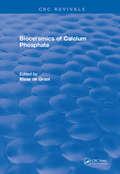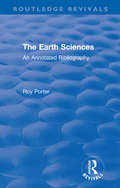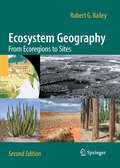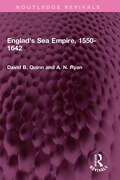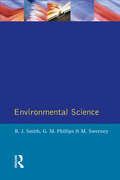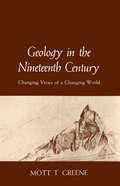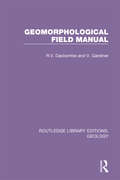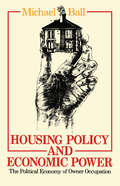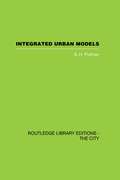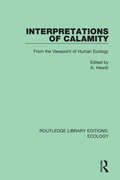- Table View
- List View
Urbanism Without Effort: Reconnecting with First Principles of the City (Island Press E-ssentials Ser.)
by Charles R. WolfeHow do you create inviting and authentic urban environments where people feel at home? Countless community engagement workshops, studies by consulting firms, and downtown revitalization campaigns have attempted to answer this age-old question. In Urbanism Without Effort, Chuck Wolfe argues that "unplanned” places can often teach us more about great placemaking than planned ones. From impromptu movie nights in a Seattle alley to the adapted reuse of Diocletian's Palace in Split, Croatia, Wolfe searches for the "first principles” of what makes humans feel happy and safe amid the hustle and bustle of urban life. He highlights the common elements of cities around the world that spontaneously bring people together: being inherently walkable, factors that contribute to safety at night, the importance of intersections and corners, and more. In this age of skyrocketing metropolitan growth, he argues, looking to the past might be our best approach to creating the urban future we dream about. A whirlwind global tour, Urbanism Without Effort offers readers inspiration, historical context, and a better understanding of how an inviting urban environment is created.
Urbanization in Israel (Routledge Library Editions: Urbanization #3)
by Elisha EfratOriginally published in 1984, Urbanization in Israel describes the urban geography of Israel, and analyses the development of urban settlements from the beginning of the 21st century. The book places special emphasis on the period since Israeli statehood and describes urbanization from a geographic, historic and planning point of view. Using a series of examples to demonstrate the process, the book looks at Jerusalem, Tel Aviv and Haifa, the old historic towns, the agricultural settlements which became towns, and the new development towns which have been established after 1948. This book will appeal to academics of geography with a focus on the development of the Middle East.
Vacant to Vibrant: Creating Successful Green Infrastructure Networks
by Sandra AlbroVacant lots, so often seen as neighborhood blight, have the potential to be a key element of community revitalization. As manufacturing cities reinvent themselves after decades of lost jobs and population, abundant vacant land resources and interest in green infrastructure are expanding opportunities for community and environmental resilience. Vacant to Vibrant explains how inexpensive green infrastructure projects can reduce stormwater runoff and pollution, and provide neighborhood amenities, especially in areas with little or no access to existing green space.Sandra Albro offers practical insights through her experience leading the five-year Vacant to Vibrant project, which piloted the creation of green infrastructure networks in Gary, Indiana; Cleveland, Ohio; and Buffalo, New York. Vacant to Vibrant provides a point of comparison among the three cities as they adapt old systems to new, green technology. An overview of the larger economic and social dynamics in play throughout the Rust Belt region establishes context for the promise of green infrastructure. Albro then offers lessons learned from the Vacant to Vibrant project, including planning, design, community engagement, implementation, and maintenance successes and challenges. An appendix shows designs and plans that can be adapted to small vacant lots.Landscape architects and other professionals whose work involves urban greening will learn new approaches for creating infrastructure networks and facilitating more equitable access to green space.
Vaquita: Science, Politics, and Crime in the Sea of Cortez
by Brooke BessesenIn 2006, vaquita, a diminutive porpoise making its home in the Upper Gulf of California, inheritedthe dubious title of world's most endangered marine mammal.Nicknamed "panda of the sea” for their small size and beguiling facial markings, vaquitas have been in decline for decades, dying by the hundreds in gillnets intended for commercially valuable fish, as wellas for anendangered fish called totoaba. When international crime cartels discovered a lucrative trade in the swim bladders of totoaba, illegal gillnetting went rampant, and now the lives of the few remaining vaquitas hang in the balance.Author Brooke Bessesen takes us on a journey to Mexico's Upper Gulf region to uncover the story. She interviewed townspeople, fishermen, scientists, and activists, teasing apart a complex story filled with villains and heroes, a story whose outcome is unclear.When diplomatic and political efforts to save the little porpoise failed, Bessesen followed a team of veterinary experts in a binational effort to capture the last remaining vaquitas and breed them in captivity—the best hope for their survival. In this fast-paced, soul-searing tale, she learned that there are no easy answers when extinction is profitable.Whether the rescue attempt succeeds or fails, the world must ask itself hard questions. When vaquita and the totoaba are gone, the black market will turn to the next vulnerable species. What will we do then?
Walkable City Rules: 101 Steps to Making Better Places
by Jeff Speck"Cities are the future of the human race, and Jeff Speck knows how to make them work.”—David Owen, staff writer at the New YorkerNearly every US city would like to be more walkable—for reasons of health, wealth, and the environment—yet few are taking the proper steps to get there. The goals are often clear, but the path is seldom easy. Jeff Speck's follow-up to his bestselling Walkable City is the resource that cities and citizens need to usher in an era of renewed street life. WalkableCity Rules is a doer's guide to making change in cities, and making it now.The 101 rules are practical yet engaging—worded for arguments at the planning commission, illustrated for clarity, and packed with specifications as well as data. For ease of use, the rules are grouped into 19 chapters that cover everything from selling walkability, to getting the parking right, escaping automobilism, making comfortable spaces and interesting places, and doing it now!Walkable City was written to inspire;Walkable City Rules was written to enable.Itis the most comprehensive tool available for bringing the latest and most effective city-planning practices to bear in your community. The content and presentation make it a force multiplier for place-makers and change-makers everywhere.
Water is for Fighting Over: and Other Myths about Water in the West
by John FleckWhen we think of water in the West, we think of conflict and crisis. In recent years, newspaper headlines have screamed,"Scarce water and the death of California farms," "The Dust Bowl returns," "A 'megadrought' will grip U.S. in thecoming decades." Yet similar stories have been appearing for decades and the taps continue to flow. John Fleck arguesthat the talk of impending doom is not only untrue, but dangerous. When people get scared, they fight for the last drop ofwater; but when they actually have less, they use less.Having covered environmental issues in the West for a quarter century, Fleck would be the last writer to discount theserious problems posed by a dwindling Colorado River. But in that time, Fleck has also seen people in the Colorado RiverBasin come together, conserve, and share the water that is available. Western communities, whether farmers and city-dwellers or US environmentalists and Mexican water managers, have a promising record of cooperation, a recordoften obscured by the crisis narrative.In this fresh take on western water, Fleck brings to light the true history of collaboration and examines the bondscurrently being forged to solve the Basin's most dire threats. Rather than perpetuate the myth "Whiskey's for drinkin', water's for fightin' over," Fleck urges readers to embrace a new, more optimistic narrative--a future where the Colorado continues to flow.
The Well-Chosen Garden
by Christopher LloydThe perfect book on how to make your garden the best it can be.'Essential reading' Country Life'Funny, encouraging, informative' Sunday TimesWould your garden, small or large, in town or country, win a prize? Is there room for improvement? Everybody has favourite plants, but the ability to put them all together to ensure a splendid show throughout the year is a skill that must be acquired. THE WELL-CHOSEN GARDEN will guide you to making the most of your available space, help you avoid untimely gaps, colour clashes and many other pitfalls of garden planning.The perfect book for new and experienced gardeners alike.
The Well-Chosen Garden
by Christopher LloydThe perfect book on how to make your garden the best it can be.'Essential reading' Country Life'Funny, encouraging, informative' Sunday TimesWould your garden, small or large, in town or country, win a prize? Is there room for improvement? Everybody has favourite plants, but the ability to put them all together to ensure a splendid show throughout the year is a skill that must be acquired. THE WELL-CHOSEN GARDEN will guide you to making the most of your available space, help you avoid untimely gaps, colour clashes and many other pitfalls of garden planning.The perfect book for new and experienced gardeners alike.
What Makes a Great City
by Alexander GarvinWhat makes a great city? City planner and architect Alexander Garvin set out to answer this question by observing cities, largely in North America and Europe, with special attention to Paris, London, New York, and Vienna.For Garvin, greatness is about what people who shape cities candotomakea city great. A great city is a dynamic, constantly changing place that residents and their leaders can reshape to satisfy their demands. Most importantly, it is about the interplay between people and public realm, and how they have interacted throughout history to create great cities.What Makes a Great Citywill help readers understand that any city can be changed for the better and inspire entrepreneurs, public officials, and city residents to do it themselves.
What Should a Clever Moose Eat?: Natural History, Ecology, and the North Woods
by Bernd Heinrich John PastorHow long should a leaf live? When should blueberries ripen? And what shoulda clever moose eat? Questions like these may seem simple or downright strange--yet they form the backbone of natural history, a discipline that fostered some of our most important scientific theories, from natural selection to glaciation. Through careful, patient observations of the organisms that live in an area, their distributions, and how they interact with other species, we gain a more complete picture of the world around us, and our place in it.In What Should a Clever Moose Eat?, John Pastor explores the natural history of the North Woods, an immense and complex forest that stretches from the western shore of Lake Superior to the far coast of Newfoundland. The North Woods is one of the most ecologically and geologically interesting places on the planet, with a host of natural history questions arising from each spruce or sugar maple. From the geological history of the region to the shapes of leaves and the relationship between aspens, caterpillars, and predators, Pastor delves into a captivating range of topics as diverse as the North Woods themselves. Through his meticulous observations of the natural world, scientists and nonscientists alike learn to ask natural history questions and form their own theories, gaining a greater understanding of and love for the North Woods--and other natural places precious to them.In the tradition of Charles Darwin and Henry David Thoreau, John Pastor is a joyful observer of nature who makes sharp connections and moves deftly from observation to theory. Take a walk in John Pastor's North Woods--you'll come away with a new appreciation for details, for the game trails, beaver ponds, and patterns of growth around you, and won't look at the natural world in the same way again.
Wild By Design: Strategies for Creating Life-Enhancing Landscapes
by Margie RuddickCan nature--in all its unruly wildness--be an integral part of creative landscape design? In her beautifully illustrated book, Wild by Design, award-winning designer Margie Ruddick urges designers to look beyond the rules often imposed by both landscaping convention and sustainability checklists. Instead, she offers a set of principles for a more creative and intuitive approach that challenges the entrenched belief that natural processes cannot complement high-level landscape design.Wild by Design defines and explains the five fundamental strategies Ruddick employs, often in combination, to give life, beauty, and meaning to landscapes: Reinvention, Restoration, Conservation, Regeneration, and Expression. Drawing on her own projects--from New York City's Queens Plaza, formerly a concrete jungle of traffic, to a desertscape backyard in Baja, California, to the Living Water Park in Chengdu, China--she offers guidance on creating beautiful, healthy landscapes that successfully reconnect people with larger natural systems.A revealing look into the approach of one of sustainable landscape design's most innovative practitioners, Wild by Design stretches the boundaries of landscape design, offering readers a set of broader, more flexible strategies and practical examples that allow for the unexpected exuberance of nature to be a welcome part of our gardens, parks, backyards, and cities.
Wildlife Law, Second Edition: A Primer
by Eric T. Freyfogle Dale D. Goble Dr Todd A. WildermuthWildlife is an important and cherished element of our natural heritage in the United States. But state and federal laws governing the ways we interact with wildlife can be complex to interpret and apply. Ten years ago, Wildlife Law: A Primer was the first book to lucidly explain wildlife law for readers with little or no legal training who needed to understand its intricacies. Today, navigating this legal terrain is trickier than ever as habitat for wildlife shrinks, technology gives us new ways to seek out wildlife, and unwanted human-wildlife interactions occur more frequently, sometimes with alarming and tragic outcomes.This revised and expanded second edition retains key sections from the first edition, describing basic legal concepts while offering important updates that address recent legal topics. New chapters cover timely issues such as private wildlife reserves and game ranches, and the increased prominence of nuisance species as well as an expanded discussion of the Endangered Species Act, now more than 40 years old. Chapter sidebars showcase pertinent legal cases illustrating real-world application of the legal concepts covered in the main text.Accessibly written, this is an essential, groundbreaking reference for professors and students in natural resource and wildlife programs, land owners, and wildlife professionals.
Agrarian Reform in Contemporary Developing Countries: A Study Prepared for the International Labour Office within the Framework of the World Employment Programme (Routledge Library Editions: Development)
by Ajit Kumar GhoseInitially published in 1983, in association with the International Labour Organisation (ILO), this book is about the meaning, relevance and process of agrarian reform in contemporary developing countries. It includes seven detailed case studies – one each on Ethiopia, Peru, Chile, Nicaragua, Iran, Kerala, (India) and West Bengal (India). In all the cases, serious contemporary efforts were made to implement agrarian reform programmes and the case studies focus upon selected aspects of this reform process – origins, basic characteristics, problems of implementation and immediate consequences. Each region differs considerably in terms of socio-economic and administrative conditions, but when the reform efforts are placed in their respective historical contexts, several common themes emerge which are dealt with in detail. In all cases, it is clear that agrarian reform is essentially a political process, requiring major social movements and that piecemeal reforms will not solve the grave problems of growth, distribution and poverty in the Third World.
Agriculture, the Countryside and Land Use: An Economic Critique (Routledge Library Editions: Agriculture #4)
by J. K. Bowers Paul CheshireFirst published in 1983. How had the situation developed in which agriculture had become such a creature of state protection, where public money supported prosperous landowners while poor farmers received practically nothing? Where the value of agricultural support exceeded net farm income, and vastly exceeded the level of support available to British Steel or British Rail? In answering these questions John Bowers and Paul Cheshire examined the real value of agricultural support in successive policy phases since the Second World War, and analysed the effects this support had on income distribution. Their thesis was that agricultural change, including the transfer of land from traditional farmers to institutions and corporations, was not the product of impersonal progress, but the direct result of agricultural support policies, resting on specious economic arguments. The authors’ analysis of this subject has inescapable relevance for the policymaker, for the taxpayer and consumer of foodstuffs, for the urban user of the British countryside and indeed for farmers and the farming lobby. Agriculture, the Countryside and Land Use will be an important book for all these groups and also for students of agriculture, geography and economics.
Bioceramics Calcium Phosphate
by K. de GrootThe first chapters are fundamental, in that the physical chemistry of calcium phosphate salts is discussed, along with mineralization (with emphasis on teeth) and remodelling of mineralized tissues. Thereafter follows a treatment of the influence of implants o surrounding hard tissues. This topic is followed by a chapter on preparation methods and biomechanical and biological aspects of calcium phosphate implants. In conclusion, two chapters are devoted to (possible) dental and medical applications. It is hoped that basic researchers can use the book in their efforts to improve this promising class of materials further, and that clinicians are inspired to define further possibilities and � at least as important � limitations.
Down Comes The Rain (Let's-Read-And-Find-Out-Science)
by Franklyn M. BranleyAfter rain comes down, the sun comes out and dries the puddles. But the water isn't gone. The heat from the sun has turned it into water vapor-it has evaporated. Eventually, this moisture in the air condenses to form new clouds. Soon the rain will fall again. Read on to find out all the ups and downpours of the water cycle!
The Earth Sciences: An Annotated Bibliography (Routledge Revivals)
by Roy PorterOriginally published in 1983, The Earth Sciences: An Annotated Bibliography is a compact and thematically organized guide that provides comprehensive access to themes and areas of study in the earth sciences. The bibliography is not exhaustive but provides a detailed and critical index to the most important literature in the field. The book’s core focus is geology and examines the subject broadly, covering everything from glaciology, geomorphology, natural history and palaeontology, to oceanography, mapping, stratigraphy and evolution. The book provides detailed essays for each bibliographical chapter on the state of each field of research and the literature compiled for each bibliography will go as far back as around 1700 and contains a wide range of sources from across the world. This book will be of interest to academics and students of natural history, geology, and environmental sciences alike.
Ecosystem Geography
by Robert G. BaileyThis book outlines a system that subdivides the Earth into a hierarchy of increasingly finer-scale ecosystems that can serve as a consistent framework for ecological analysis and management. The system consists of a three-part, nested hierarchy of ecosystem units and associated mapping criteria. This new edition has been updated throughout with new text, figures, diagrams, photographs, and tables.
Englad's Sea Empire, 1550-1642 (Routledge Revivals)
by David B. Quinn A N RyanFirst published in 1983, England’s Sea Empire was originally part of the Early Modern Europe Today book series. It explores the relationships between the increase of English merchant shipping, the growth of naval power and the early experiments in overseas trade and colonisation. No other book combines these topics for the period from the middle of the 16th to the middle of the 17th century. In dealing with economic, strategic and technical problems, the authors write in language which is intelligible to non-specialist readers. They illustrate the arguments with generous quotations from contemporary sources and with maps of the regions under discussion. This book will be of value on undergraduate courses in early British or colonial or maritime history.
Environmental Science (Longman Technician Series)
by B. J. Smith G M Phillips M SweeneyFirst published in 1983. This book aims to cover the requirements for the Business and Technician Education Council Level Three & Four Units in Environmental Science. At the same time it was recognised that there was a real need for a suitable book for those studying Building, Quantity Surveying, Architecture and Environmental Health at 1st degree level. This book should therefore form a useful first year introductory text for both ‘A’ level and BTEC entrants. The book contains a large number of worked examples in the text as well as many student questions at the end of each chapter. Experiments have been included, not with the intention of being exhaustive, but to give ideas. Some areas of work lend themselves to student practical work better than others so that some inbalance is inevitable. ‘Environmental Science’ should give students an introduction to the environmental problems in construction and the methods which may be used to provide a satisfactory and economic solution.
Geology in the Nineteenth Century: Changing Views of a Changing World
by Mott T. GreeneIn this clear and comprehensive introduction to developments in geological theory during the nineteenth century, Mott T. Greene asserts that the standard accounts of nineteenth-century geology, which dwell on the work of Anglo-American scientists, have obscured the important contributions of Continental geologists; he balances this traditional emphasis with a close study of the innovations of the French, German, Austro-Hungarian, and Swiss geologists whose comprehensive theory of earth history actually dominated geological thought of the time. Greene's account of the Continental scientists places the history of geology in a new light: it demonstrates that scientific interest in the late nineteenth century shifted from uniform and steady processes to periodic and cyclic events—rather than the other way around, as the Anglo-American view has represented it. He also puts continental drift theory in its context, showing that it was not a revolutionary idea but one that emerged naturally from the Continental geologists' foremost subject of study-the origin of mountains, oceans, and continents. A careful inquiry into the nature of geology as a field poised between natural history and physical science, Geology in the Nineteenth Century will interest students and scholars of geology, geophysics, and geography as well as intellectual historians and historians of science.
Geomorphological Field Manual (Routledge Library Editions: Geology #12)
by R. Dackombe V. GardinerThis book, first published in 1983, incorporates a wealth of reference material – keys, nomograms, tables, charts – likely to be needed in the field for actual fieldwork. The widest possible coverage of material is provided in anticipation of problems that individual specialists will encounter on the periphery of their main areas of interest.
Housing Policy and Economic Power: The Political Economy of Owner Occupation
by Michael Ball Professor Michael BallPublished in 2002, Housing Policy and Economic Power is a valuable contribution to the field of Human Geography.
Integrated Urban Models Volume 1 (RLE: The City): New Research And Applications Of Optimization And Dynamics
by S. H. PutmanThis book was first published in 1983.
Interpretations of Calamity: From the Viewpoint of Human Ecology (Routledge Library Editions: Ecology #4)
by K. HewittOriginally published in 1983, Interpretations of Calamity provides a provocative critique of the ‘dominant view’ of research into natural hazards. Throughout the world, there are now many people professionally engaged in the mitigation and control of risks & hazards, and the impact of continuing economic development will ensure that they are fully employed. There is a wealth of perspectives in the book, including weather and wheat yields in the Soviet Union and Canada, an historical view of underdevelopment and hazards in Ireland and the impact of a response to drought in southern Africa, the Sahel and the Great Plains of the USA. The book reflects the major themes of hazards in the context of economic development and social change. Most of the case studies are from the rural and agriculture scene. This book provides a unique view of the vital importance of food production and of the considerable, and sometimes calamitous, impact that frost, flood, storm and drought have on the wellbeing of millions of people and on the stability of the international economic system.
